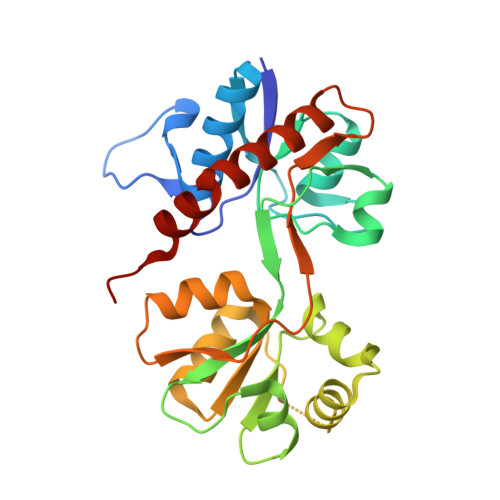Partial agonism and antagonism of the ionotropic glutamate receptor iGLuR5: structures of the ligand-binding core in complex with domoic acid and 2-amino-3-[5-tert-butyl-3-(phosphonomethoxy)-4-isoxazolyl]propionic acid.
Hald, H., Naur, P., Pickering, D.S., Sprogoe, D., Madsen, U., Timmermann, D.B., Ahring, P.K., Liljefors, T., Schousboe, A., Egebjerg, J., Gajhede, M., Kastrup, J.S.(2007) J Biol Chem 282: 25726-25736
- PubMed: 17581823
- DOI: https://doi.org/10.1074/jbc.M700137200
- Primary Citation of Related Structures:
1VSO, 2PBW - PubMed Abstract:
More than 50 structures have been reported on the ligand-binding core of the ionotropic glutamate receptor iGluR2 that belongs to the 2-amino-3-(3-hydroxy-5-methyl-4-isoxazolyl)propionic acid-type of receptors. In contrast, the ligand-binding core of the kainic acid-type receptor iGluR5 has only been crystallized with three different ligands. Hence, additional structures of iGluR5 are needed to broaden the understanding of the ligand-binding properties of iGluR5, and the conformational changes leading to channel opening and closing. Here, we present two structures of the ligand-binding core of iGluR5; one as a complex with the partial agonist (2S,3S,4S)-3-carboxymethyl-4-[(1Z,3E,5R)-5-carboxy-1-methyl-hexa-1,3-dienyl]-pyrrolidine-2-carboxylic acid (domoic acid) and one as a complex with the antagonist (S)-2-amino-3-[5-tert-butyl-3-(phosphonomethoxy)-4-isoxazolyl]propionic acid ((S)-ATPO). In agreement with the partial agonist activity of domoic acid, the ligand-binding core of the iGluR5 complex is stabilized by domoic acid in a conformation that is 11 degrees more open than the conformation observed in the full agonist (S)-glutamic acid complex. This is primarily caused by the 5-carboxy-1-methyl-hexa-1,3-dienyl moiety of domoic acid and residues Val685-Thr690 of iGluR5. An even larger domain opening of 28 degrees is introduced upon binding of the antagonist (S)-ATPO. It appears that the span of domain opening is much larger in the ligand-binding core of iGluR5 (30 degrees) compared with what has been observed in iGluR2 (19 degrees ). Similarly, much larger variation in the distances between transmembrane linker residues in the two protomers comprising the dimer is observed in iGluR5 as compared with iGluR2.
Organizational Affiliation:
Department of Medicinal Chemistry, Faculty of Pharmaceutical Sciences, University of Copenhagen, Universitetsparken 2, DK-2100, Copenhagen, Denmark.
















